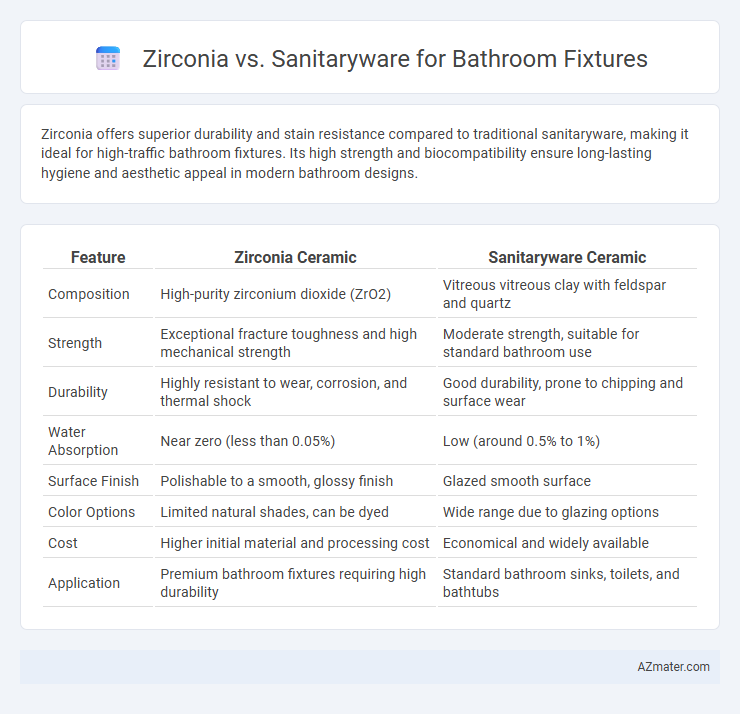Zirconia offers superior durability and stain resistance compared to traditional sanitaryware, making it ideal for high-traffic bathroom fixtures. Its high strength and biocompatibility ensure long-lasting hygiene and aesthetic appeal in modern bathroom designs.
Table of Comparison
| Feature | Zirconia Ceramic | Sanitaryware Ceramic |
|---|---|---|
| Composition | High-purity zirconium dioxide (ZrO2) | Vitreous vitreous clay with feldspar and quartz |
| Strength | Exceptional fracture toughness and high mechanical strength | Moderate strength, suitable for standard bathroom use |
| Durability | Highly resistant to wear, corrosion, and thermal shock | Good durability, prone to chipping and surface wear |
| Water Absorption | Near zero (less than 0.05%) | Low (around 0.5% to 1%) |
| Surface Finish | Polishable to a smooth, glossy finish | Glazed smooth surface |
| Color Options | Limited natural shades, can be dyed | Wide range due to glazing options |
| Cost | Higher initial material and processing cost | Economical and widely available |
| Application | Premium bathroom fixtures requiring high durability | Standard bathroom sinks, toilets, and bathtubs |
Introduction to Zirconia and Sanitaryware
Zirconia, a high-performance ceramic material known for its strength and durability, is increasingly used in advanced bathroom fixtures to enhance longevity and aesthetic appeal. Sanitaryware, encompassing traditional bathroom fixtures such as toilets, sinks, and bathtubs, is typically made from ceramic, porcelain, or vitreous china, valued for its smooth finish and ease of cleaning. The integration of zirconia into sanitaryware offers improved resistance to wear, fracture, and staining compared to conventional ceramic materials.
Material Composition and Properties
Zirconia, primarily composed of zirconium dioxide, offers exceptional toughness, wear resistance, and biocompatibility, making it ideal for high-performance bathroom fixtures. Sanitaryware, typically made from vitreous china or porcelain, features a glazed ceramic surface that provides excellent hygiene, ease of cleaning, and durability under routine use. The superior fracture toughness and thermal stability of zirconia contrast with the cost-effectiveness and established manufacturing processes of vitreous sanitaryware, influencing their respective applications in modern bathrooms.
Aesthetic Differences
Zirconia offers a sleek, high-gloss finish with a smooth surface that enhances modern bathroom aesthetics, while traditional sanitaryware often features matte or semi-gloss textures catering to classic styles. Zirconia's fine grain structure allows for more intricate, precise shapes and a uniform color palette that resists staining and discoloration over time. The material's superior translucency and brightness create a visually striking contrast compared to the more utilitarian appearance of standard sanitaryware fixtures.
Durability and Longevity
Zirconia offers superior durability and longevity compared to traditional sanitaryware due to its high fracture toughness and resistance to wear and corrosion. Sanitaryware materials like ceramic or porcelain, while cost-effective, tend to chip or crack over time, especially under heavy usage. The advanced material properties of zirconia ensure bathroom fixtures remain intact and functional for decades with minimal maintenance.
Stain and Scratch Resistance
Zirconia offers superior stain and scratch resistance compared to traditional sanitaryware, making it an excellent choice for bathroom fixtures that require durability and long-lasting aesthetics. Its dense, non-porous surface resists discoloration from common bathroom substances, while its hardness minimizes surface abrasions and maintains a polished appearance. Sanitaryware materials, such as ceramic or porcelain, are more prone to staining and surface wear, leading to frequent maintenance and potential replacement.
Maintenance and Cleaning Requirements
Zirconia bathroom fixtures offer exceptional durability and stain resistance, making them easier to maintain and clean compared to traditional sanitaryware. Sanitaryware, typically made from ceramic or porcelain, requires regular deep cleaning to prevent staining and surface wear over time. Zirconia's non-porous surface minimizes bacterial growth and reduces the need for harsh cleaning chemicals, enhancing overall hygiene and longevity.
Cost Comparison
Zirconia bathroom fixtures typically cost significantly more than standard sanitaryware due to their superior durability, high-quality material composition, and advanced manufacturing processes. While sanitaryware offers budget-friendly options with moderate strength and aesthetic appeal, zirconia's price can be up to three times higher, reflecting its long-term investment value and resistance to wear and stains. Choosing between zirconia and sanitaryware depends on balancing initial cost against longevity and maintenance expenses in bathroom fixture installations.
Eco-Friendliness and Sustainability
Zirconia, a high-performance ceramic known for its durability and low porosity, offers an eco-friendly alternative to traditional sanitaryware by reducing water absorption and minimizing bacterial growth, thereby enhancing hygiene with less frequent cleaning. Sanitaryware made from traditional porcelain or vitreous china often involves higher energy consumption during firing and generates more waste, whereas zirconia's longer lifespan and lower maintenance contribute to sustainability by decreasing replacement frequency and resource use. Choosing zirconia bathroom fixtures supports sustainable building practices by combining durability, reduced water use, and lower environmental impact throughout the product lifecycle.
Installation Considerations
Zirconia bathroom fixtures require precise installation techniques due to their high hardness and brittleness, necessitating specialized tools and skilled labor to avoid cracking during mounting. Sanitaryware, typically made from ceramic materials, offers easier installation with standard plumbing fittings and less risk of damage, making it more suitable for quick and cost-effective bathroom renovations. Proper sealing and support are crucial for both materials to ensure durability and prevent leaks, with zirconia fixtures demanding more stringent handling protocols.
Which Is Best for Your Bathroom?
Zirconia offers superior durability and resistance to wear, making it ideal for long-lasting bathroom fixtures, while sanitaryware commonly refers to traditional ceramics valued for affordability and ease of maintenance. Zirconia's high fracture toughness and biocompatibility enhance hygiene and longevity, making it suitable for modern, high-end bathrooms. Choosing between zirconia and sanitaryware depends on budget considerations, desired aesthetics, and the level of durability required for your bathroom environment.

Infographic: Zirconia vs Sanitaryware for Bathroom Fixture
 azmater.com
azmater.com